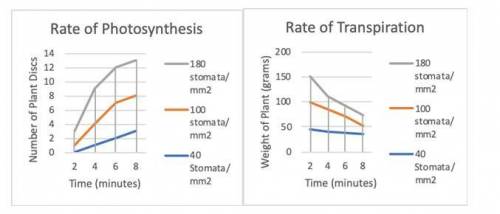
Biology, 06.11.2020 02:50, carolinerosewillis
4. Students testing the effects of stomata count on the rate of transpiration completed a corresponding test on the same plants using the “plant disk” method.
a) Describe the relationship between the rate of transpiration and the rate of photosynthesis visible in the data.
b) Explain why the environmental factors that affect transpiration can also affect photosynthesis.


Answers: 1
Other questions on the subject: Biology

Biology, 22.06.2019 01:00, gabrielaperezcz
Dermal tissue in plants stores 1.extra food 2.transports water and nutrients 3.transports waste materials 4.is similar to epithelial cells in animals
Answers: 1

Biology, 22.06.2019 01:20, hannahpelkey
Which organelles are labeled d, and what is one feature that distinguishes them from the other labeled organelles chloroplasts the only organelles that produce sugars from sunlight mosomes, only found in animal and bacterial cells centricles only found in animal cells mitochondra, the only energo-generating structures found in cells
Answers: 1

Biology, 22.06.2019 13:30, staffordkimberly
What are levels of ecology and how can we remember them
Answers: 1

Biology, 22.06.2019 16:30, leannesmith90101
You will create a molecular clock model for an arthropod gene. follow these guidelines to make your model: . your timeline will span from 90 million years ago to the present. the common ancestor in your model is an arthropod that lived 90 million years ago. the gene that you'll track codes for a protein in the species venom . the dna sequence youll track contains 10 nitrogen bases. you can choose the order of the bases and where the mutations occur. this gene mutates at a rate of approximately 0.76 base pairs every 17.1 million years. to build your model,/ calculate the estimated time period it takes for 1 base pair to mutate. the first time period will only show the common ancestor. at the beginning of the second time period, three lineages will diverge from the common ancestor, each with a different mutation in their gene sequences. the first and third descendant species will survive for the rest of the timeline. the second descendant species was extinct 50 million years ago. calculate how long it will take for one full base pair mutation to occur. explain your reasoning by constructing a mathematical equation
Answers: 2
Do you know the correct answer?
4. Students testing the effects of stomata count on the rate of transpiration completed a correspond...
Questions in other subjects:

Mathematics, 27.04.2021 01:00


Mathematics, 27.04.2021 01:00

Mathematics, 27.04.2021 01:00

Mathematics, 27.04.2021 01:00

Mathematics, 27.04.2021 01:00

Engineering, 27.04.2021 01:00


Social Studies, 27.04.2021 01:00







